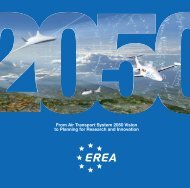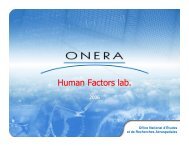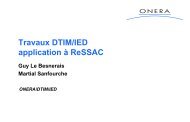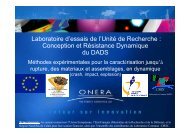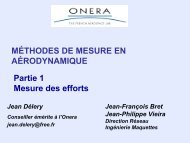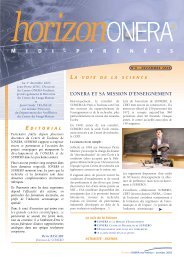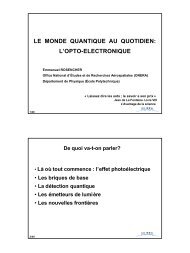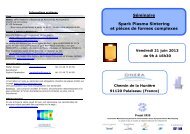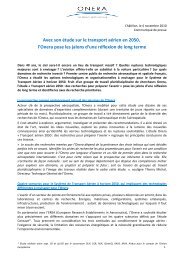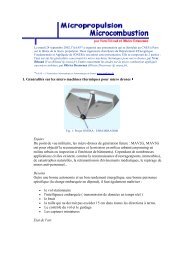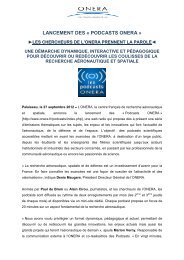IESTA (Infrastructure for Air Transport System Evaluation): a ... - Onera
IESTA (Infrastructure for Air Transport System Evaluation): a ... - Onera
IESTA (Infrastructure for Air Transport System Evaluation): a ... - Onera
Create successful ePaper yourself
Turn your PDF publications into a flip-book with our unique Google optimized e-Paper software.
provide useful in<strong>for</strong>mation on improvements on system capacity/safety and related<br />
environmental impact. In this evolutionary European context, the French Aerospace<br />
Laboratory (ONERA) is carrying out an ambitious program (<strong>IESTA</strong>) to design a modeling<br />
and simulation infrastructure able of evaluating innovative air transport concepts. This<br />
plat<strong>for</strong>m has to be considered as a mean to help harmonization of pan-European assessment<br />
tools <strong>for</strong> innovative research on future <strong>Air</strong> <strong>Transport</strong> <strong>System</strong>s (ATS).<br />
This paper firstly introduces organizational issues of the <strong>IESTA</strong> Program focusing on<br />
expected benefits of the underlying approach from the customer's point of view. Then, we<br />
present the characteristics of every acoustics components implies in acoustics impacts<br />
evaluation around airport: Three phases are detailed: Pre-Simulation phase, Simulation phase<br />
and Post-Simulation phase. We then discuss system architectural issues of the plat<strong>for</strong>m as<br />
well as technological features. Finally, we give a detailed presentation of a rapid prototype of<br />
the first version (application) of <strong>IESTA</strong>, called Clean <strong>Air</strong>port, aiming at assessing noise<br />
impact during the Landing and Take-Off (LTO) phases on airports vicinity. This prototype<br />
has been design to evaluate the relevance and efficiency of a set of well known existing tools<br />
to achieve the requirements of <strong>IESTA</strong>/Clean <strong>Air</strong>port plat<strong>for</strong>m, focusing on noise propagation<br />
and impact. Tools used include the ONERA CERTI HLA Run-time <strong>Infrastructure</strong><br />
(http://www.cert.fr/CERTI/), X-Plane simulation outputs (X-Plane by Laminar Research,<br />
www.x-plane.com/), Google Earth and related tools.<br />
2 THE <strong>IESTA</strong> PROGRAM<br />
The ambition of the <strong>IESTA</strong> Program is to offer an infrastructure <strong>for</strong> evaluating future<br />
concepts <strong>for</strong> air transport systems through an advanced <strong>for</strong>malization procedure. This<br />
program then participates in the world wide ef<strong>for</strong>t to face the challenge of sustainable<br />
development and to achieve ambitious goals, particularly with regard to security,<br />
environment and capacity. <strong>IESTA</strong> unifies all the aeronautical skills of ONERA in physics<br />
modeling and its know-how in terms of system evaluation and simulation architecture to<br />
provide a unique service <strong>for</strong> the benefit of players in the air transport industry who are<br />
interested to evaluate the per<strong>for</strong>mance and impact of their innovations in a more<br />
comprehensive way.<br />
<strong>IESTA</strong> is a 5 years Program built around 2 main projects, <strong>IESTA</strong>/AMO the responsibility<br />
of which is to deliver a set of computational modules, and <strong>IESTA</strong>/IMI aiming at integrating<br />
those modules within a given computational plat<strong>for</strong>m. Computational modules include noise<br />
propagation, chemical species emission and propagation, engines burning, aircraft dynamics,<br />
aircraft planning and maneuvering on the airport layout, en route flight plans etc. A set of<br />
long term thematic studies are also carried out in parallel in order to model system<br />
components and evaluation methodologies through internal and external co operations. Two<br />
applications of <strong>IESTA</strong> have been selected in a previous specification phase, each one<br />
addressing a set of relevant study cases:<br />
1) Clean <strong>Air</strong>port (<strong>IESTA</strong>.V1 version), a set of computing facilities and models to<br />
assess the airport impact on environment in terms of noise and chemical emissions.<br />
2) SimSky (<strong>IESTA</strong>.V2 version) addressing evaluation of innovative ATS concepts<br />
across the entire airspace.<br />
A first version of <strong>IESTA</strong>/Clean <strong>Air</strong>port will be delivered by June 2009, while<br />
<strong>IESTA</strong>/SimSky version is expected to be available by 2011. The <strong>IESTA</strong> Program should lead<br />
to the availability of a unique plat<strong>for</strong>m benefiting from the ONERA aerospace research<br />
environment, a large scale computing power and the multidisciplinary teams of engineers and<br />
scientists. Exploitations plans of the plat<strong>for</strong>m are very similar to those of ONERA wind<br />
tunnel facilities. Customers (civil aviation authorities, aircraft industries, airlines, airport



